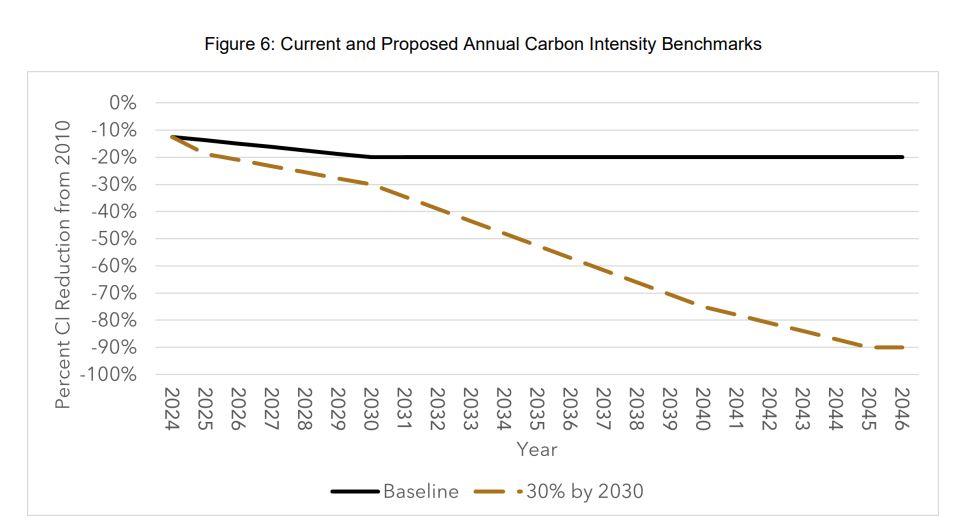CARB Proposes Steep CI Reduction Targets in Proposed LCFS Amendments
By Brad Pleima, President
The long-awaited and much-anticipated draft rulemaking for California’s Low-Carbon Fuel Standard (LCFS) is out. Some significant changes, even from the Standardized Regulatory Impact Assessment (SRIA), were outlined in September.
Below are some initial highlights/summary points from the 146-page release:
- California’s Air Resources Board (CARB) is increasing the 2030 compliance target from 20% to 30% and 90% by 2045. This probably isn’t enough to immediately impact LCFS credit prices in the short term. Our modeling and analysis show potential increasing LCFS credit prices in the latter parts of the decade (even with the auto-acceleration mechanism, AAM).
- Dairy/swine projects that rely on avoided methane emission crediting and breaking ground after December 31, 2029, will be subject to credit phase-out. Crediting will be available through 2040 for compressed natural gas (CNG) usage and through 2045 for renewable natural gas (RNG) used to produce hydrogen. Facilities that break ground before the end of 2029 will be able to generate credits for 30 years following approval of the application.
- The RNG deliverability/book and claim issue that concerned many people in the SRIA will happen, but CARB greatly extended the timelines. Deliverability requirements will follow the RNG/CNG pathway phase out and projects that break ground after 2029 will be required to demonstrate physical deliverability requirements beginning in January of 2041. Biomethane used as an input for hydrogen production will have deliverability requirements starting January 1, 2046. Projects that break ground before 2030 are not subject to deliverability requirements. Deliverability requirements apply to biomethane fuel pathways only and would not apply to biomethane used in hydrogen fuel pathways.
- Sustainable aviation fuel (SAF) used in intrastate air travel will not be exempt from the LCFS program beginning in 2028.
- Several changes to simplify the Tier 1 calculators and add a Tier 1 hydrogen calculator. Updates to the Tier 1 calculator are to include updated emissions factors, streamlined inputs, and a new layout. Temporary Pathways and Lookup Table carbon intensity (CI) values are to be updated for specified pathways.
- The energy economy ratio (EER) for electric forklifts is reduced by 50% for forklifts less than 12,000 pounds. This will cut the credits generated in half. In addition, direct metering of electricity used in electric forklifts will be required.
- Zero-emission vehicle (ZEV) infrastructure crediting is being expanded to include medium-and-heavy duty infrastructure and extend light-duty infrastructure crediting. Additional changes are to occur for non-metered residential electric vehicle (EV) charging as well, two of which include changing the scope of the Clean Fuel Reward to a medium-and-heavy duty rebate and expanding the proportion of credit proceeds required to be invested in disadvantaged, low-income, rural, and tribal communities.
- Credits from petroleum projects are to be phased out by 2040, but carbon capture and sequestration (CCS) projects are to be excluded from the phase-out proposal.
- Direct air capture (DAC) with sequestration project credits will be limited only to projects located in the U.S. This will not apply to DAC-to-fuel projects submitted as Tier 2 Alternative Fuel Pathways.
- New requirements are to be put in place to track the supply chain of crop-based and forestry-based feedstocks to their point of origin and require independent feedstock certification. In addition, palm-derived fuels will no longer be eligible for generation.
- Book-and-claim allowance is being expanded to include low-CI hydrogen injected into the pipeline network physically connected to California. The well-to-wheel CI threshold for low-carbon hydrogen is to be less than or equal to 55 g/MJ (grams per megajoule) for gaseous hydrogen and 95g/MJ for liquid hydrogen. Hydrogen from fossil gas will be excluded from book-and-claim, with some exceptions. Additionally, power purchase agreements for low-CI electricity will allow for hydrogen used as a transportation fuel.
- CARB is proposing to add new verification requirements on electric technologies, some of which include EV-charging transaction types, fuel cell vehicle fueling transaction types, and fixed guideway electricity fueling.

Bottom line – get your RNG projects developed before 2030 to be eligible for up to 30 years of crediting. Crop-based/forestry-based feedstock fuels will have significant traceability and certification requirements. Several rules on hydrogen production, dispensing, and crediting are to be put in place. Multiple technologies and fuel pathways will be seeing changes in credit eligibility and new requirements.
CARB gets a lot of flak but, after an initial read, they seem to have done a good job balancing all interests along with providing more clarity across many issues. This proposed rulemaking greatly strengthens the LCFS program through 2045.
There is a lot more in the draft and our team is reviewing it in more detail. Stay tuned for a deeper analysis.

Brad Pleima, President | bpleima@ecoengineers.us




